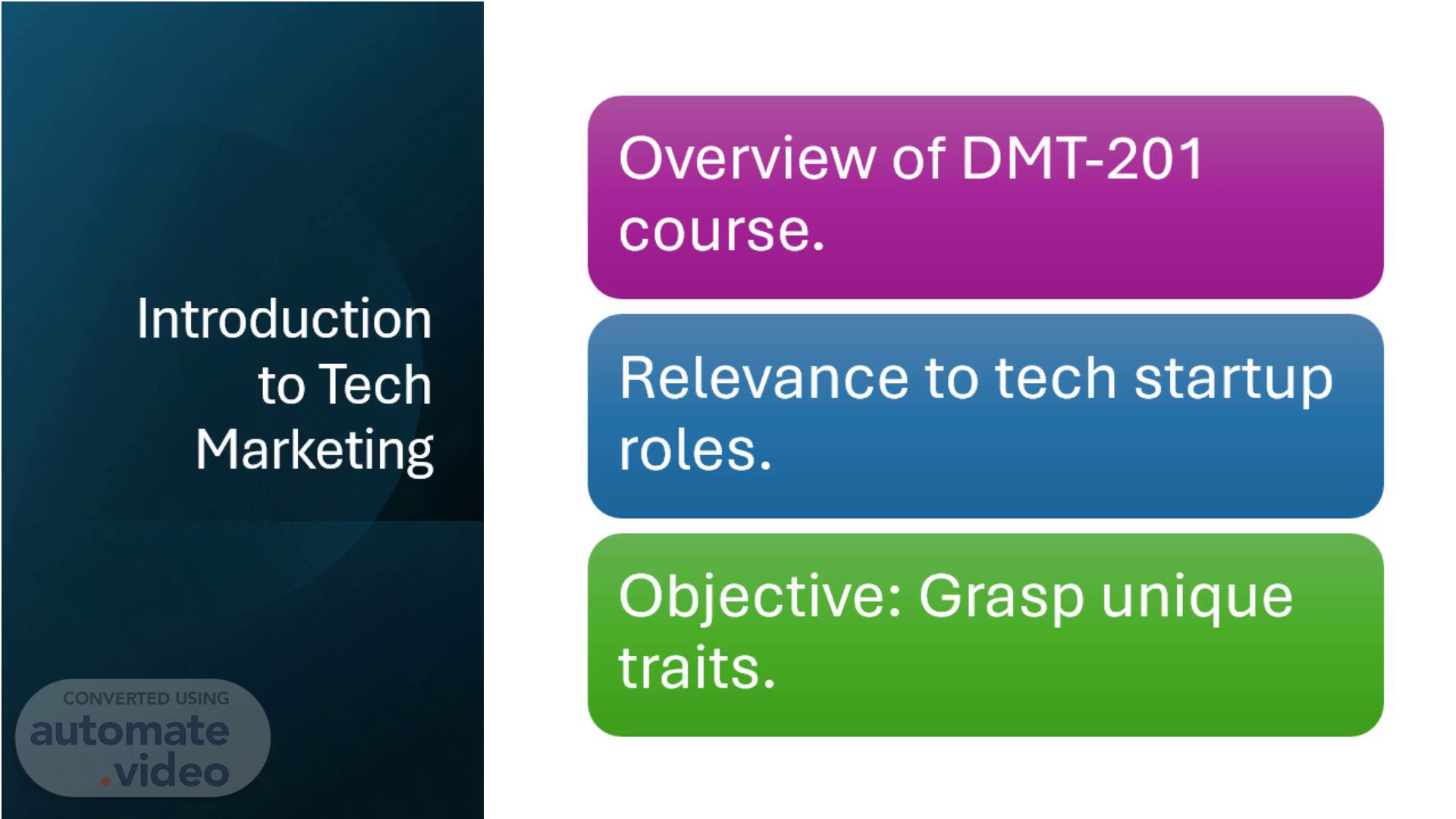Scene 1 (0s)
[Audio] Welcome to Introduction to Digital Marketing for Tech Startups, DMT-201. I'm Robin Morris, and I'm here to guide you through mastering marketing for the tech world. Whether you're in product development, sales, or operations at a startup, this course delivers practical skills to amplify your company's growth. We begin with Module 1, Lesson 1: What Makes Tech Marketing Unique? Our focus today is understanding the distinct characteristics that differentiate tech marketing from traditional approaches. Let's dive into this critical foundation..
Scene 2 (36s)
[Audio] Tech marketing stands apart from consumer marketing in fundamental ways. Unlike consumer goods, where a customer might spontaneously buy a $25 item, tech products—like software or enterprise solutions—don't sell on a whim. Buyers, such as IT managers or business owners, invest significant time researching features, costs, and competitors, often over weeks or months. They're not drawn in by glitzy campaigns alone. Instead, they demand tangible value, reliability, and evidence of effectiveness. This deliberate process shapes our entire marketing strategy..
Scene 3 (1m 21s)
[Audio] Another key distinction is the audience complexity. In tech, decisions involve multiple stakeholders with diverse priorities. The CTO cares about functionality—'Does it integrate?' The CFO asks, 'What's the ROI?' Operations might push for ease of use. Your messaging must address all these perspectives effectively. For example, pitching a clinic management tool means proving efficiency to staff and profitability to leadership. It's a multifaceted challenge requiring precision..
Scene 4 (1m 53s)
[Audio] At its core, tech marketing revolves around problem-solving. Your audience faces concrete issues—perhaps inefficient processes or unreliable systems. Your role is to identify those pain points and present solutions with measurable outcomes. Consider a pitch for software that reduces system downtime by 20% or accelerates data processing by 30%. These aren't empty promises; they're verifiable results that buyers can evaluate. By focusing on solutions, you position your marketing as a trusted resource rather than a hard sell..
Scene 5 (2m 29s)
[Audio] Evidence is the backbone of tech marketing. Unlike consumer markets where emotional appeals might suffice, tech buyers lean heavily on proof. They want data, case studies, or testimonials that validate your solution's impact. For instance, a fintech startup might showcase how its platform saved clients an average of 15 hours monthly. This reliance on facts builds credibility. Trust, earned through transparency and results, becomes the deciding factor in their commitment. It's about substance over style every time..
Scene 6 (3m 4s)
[Audio] How do you apply this? Start by mapping your buyer. Understanding their identity, challenges, and objectives is your first actionable step. Download the Tech Buyer Persona Template from LearnDash to streamline this process. In just 10 minutes, you can detail their job role, key pain points, and decision criteria. This exercise isn't optional—it's the bedrock of successful tech marketing. That concludes Lesson 1. Next, we'll channel this clarity into setting goals. See you in Lesson 2..
Scene 7 (3m 39s)
[Audio] Welcome back to DMT-201. I'm Robin Morris, and this is Module 1, Lesson 2: Setting Clear Marketing Goals. You've defined your tech buyer from Lesson 1—now it's time to decide what to achieve with them. Goals give your marketing purpose, ensuring you're not just chasing vague notions like 'brand awareness.' For startups offering software or services, well-defined goals align your efforts with tangible growth outcomes. Let's unpack how to craft goals that deliver results..
Scene 8 (4m 11s)
[Audio] The gold standard here is SMART goals: Specific, Measurable, Achievable, Relevant, Time-bound. A goal like 'expand our reach' lacks focus. Contrast that with 'acquire 12 new client demos in 14 days through a webinar.' It's specific—you know the target. It's measurable—12 demos can be counted. It's achievable with planning, relevant to business growth, and time-bound with a two-week deadline. SMART goals transform ambiguity into a clear plan..
Scene 9 (4m 47s)
[Audio] Specificity is the starting point. Consider 'improve website visits' versus 'attract 40 IT decision-makers to our site with a blog series.' The latter ties directly to your buyer's needs—perhaps they're seeking integration solutions. Vague goals lead to scattered efforts, while precise ones guide your actions. Specificity answers 'what' and 'who,' setting the stage for execution. It's the difference between wandering and targeting with intent..
Scene 10 (5m 19s)
[Audio] Measurable goals are your proof of progress. 'Increase leads' is hard to gauge, but 'generate 8 qualified leads monthly' gives you a benchmark. Tools like Google Analytics can track site visits, while a CRM logs lead conversions. When you report 'our last campaign delivered 15 demos,' you're not guessing—you're showing evidence. For tech-savvy buyers, this data-driven approach reinforces your reliability. Measurement turns goals into accountability..
Scene 11 (5m 51s)
[Audio] Achievable, Relevant, and Time-bound round out SMART. '100 demos in a day' might sound bold, but is it realistic with your team and budget? Scale it to '10 demos in a week'—challenging yet doable. Relevance ties it to your startup's priorities, like client acquisition. Time-bound adds a deadline—say, 'by month's end'—to keep momentum. These elements ensure your goals aren't pipe dreams but practical steps forward..
Scene 12 (6m 22s)
[Audio] Time to act: set your own SMART goal. Download the SMART Goal Worksheet from LearnDash—it's a step-by-step guide through Specific, Measurable, Achievable, Relevant, and Time-bound. Try 'secure 10 trial sign-ups in 7 days via email outreach.' It takes 10 minutes and locks in your learning. That's Lesson 2 complete. In Module 2, we'll build your online presence with this foundation. See you there with more strategies to succeed..
